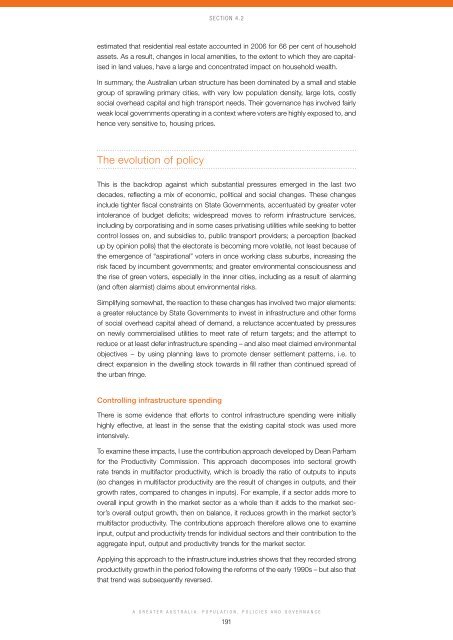A Greater Australia: Population, policies and governance - CEDA
A Greater Australia: Population, policies and governance - CEDA
A Greater Australia: Population, policies and governance - CEDA
- No tags were found...
You also want an ePaper? Increase the reach of your titles
YUMPU automatically turns print PDFs into web optimized ePapers that Google loves.
Section 4.2estimated that residential real estate accounted in 2006 for 66 per cent of householdassets. As a result, changes in local amenities, to the extent to which they are capitalisedin l<strong>and</strong> values, have a large <strong>and</strong> concentrated impact on household wealth.In summary, the <strong>Australia</strong>n urban structure has been dominated by a small <strong>and</strong> stablegroup of sprawling primary cities, with very low population density, large lots, costlysocial overhead capital <strong>and</strong> high transport needs. Their <strong>governance</strong> has involved fairlyweak local governments operating in a context where voters are highly exposed to, <strong>and</strong>hence very sensitive to, housing prices.The evolution of policyThis is the backdrop against which substantial pressures emerged in the last twodecades, reflecting a mix of economic, political <strong>and</strong> social changes. These changesinclude tighter fiscal constraints on State Governments, accentuated by greater voterintolerance of budget deficits; widespread moves to reform infrastructure services,including by corporatising <strong>and</strong> in some cases privatising utilities while seeking to bettercontrol losses on, <strong>and</strong> subsidies to, public transport providers; a perception (backedup by opinion polls) that the electorate is becoming more volatile, not least because ofthe emergence of “aspirational” voters in once working class suburbs, increasing therisk faced by incumbent governments; <strong>and</strong> greater environmental consciousness <strong>and</strong>the rise of green voters, especially in the inner cities, including as a result of alarming(<strong>and</strong> often alarmist) claims about environmental risks.Simplifying somewhat, the reaction to these changes has involved two major elements:a greater reluctance by State Governments to invest in infrastructure <strong>and</strong> other formsof social overhead capital ahead of dem<strong>and</strong>, a reluctance accentuated by pressureson newly commercialised utilities to meet rate of return targets; <strong>and</strong> the attempt toreduce or at least defer infrastructure spending – <strong>and</strong> also meet claimed environmentalobjectives − by using planning laws to promote denser settlement patterns, i.e. todirect expansion in the dwelling stock towards in fill rather than continued spread ofthe urban fringe.Controlling infrastructure spendingThere is some evidence that efforts to control infrastructure spending were initiallyhighly effective, at least in the sense that the existing capital stock was used moreintensively.To examine these impacts, I use the contribution approach developed by Dean Parhamfor the Productivity Commission. This approach decomposes into sectoral growthrate trends in multifactor productivity, which is broadly the ratio of outputs to inputs(so changes in multifactor productivity are the result of changes in outputs, <strong>and</strong> theirgrowth rates, compared to changes in inputs). For example, if a sector adds more tooverall input growth in the market sector as a whole than it adds to the market sector’soverall output growth, then on balance, it reduces growth in the market sector’smultifactor productivity. The contributions approach therefore allows one to examineinput, output <strong>and</strong> productivity trends for individual sectors <strong>and</strong> their contribution to theaggregate input, output <strong>and</strong> productivity trends for the market sector.Applying this approach to the infrastructure industries shows that they recorded strongproductivity growth in the period following the reforms of the early 1990s – but also thatthat trend was subsequently reversed.A <strong>Greater</strong> <strong>Australia</strong>: <strong>Population</strong>, Policies <strong>and</strong> Governance191





